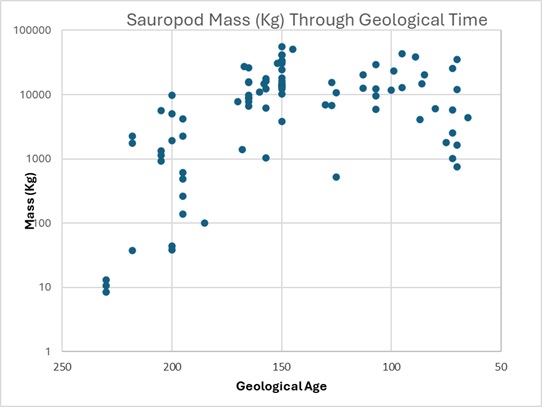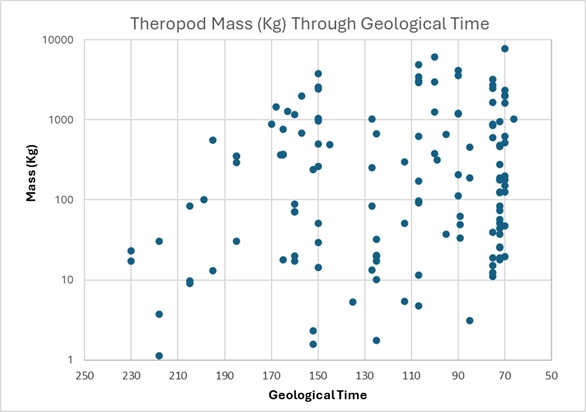
Changing the way we look at the world
In this blog I want to look at some interesting data extracted from a publication on mass (i.e. size) of dinosaurs over time.
First a recap on dinosaur fossils which are found in Mesozoic rocks.
The oldest Mesozoic rocks are Triassic.
Jurassic rocks are younger, and Cretaceous rocks are the most recent Mesozoic rocks.
These rocks contain fossils of many types of creatures - including the dinosaurs.
There are three main groups (clades) of dinosaurs: theropods, sauropods and ornithischians.
The most diverse group is the ornithischian dinosaurs which were many different shapes;
some with defensive horns and armour and others with clubs or spikes on their tails.
Theropods and sauropods are not as diverse.
Theropods were all bipedal and mostly carnivores.
Sauropods were all tetrapods and vegetarian.
The oldest dinosaurs, which are found in Triassic rocks, were smaller than those found in later
Jurassic and Cretaceous rocks.
Benson, R. B., Campione, N. E., Carrano, M. T., Mannion, P. D., Sullivan, C., Upchurch, P., & Evans, D. C. (2014). Rates of dinosaur body mass evolution indicate 170 million years of sustained ecological innovation on the avian stem lineage. PLoS Biology, 12(5)
Benson et al analysed the mass of dinosaur from the Triassic to the end of the Cretaceous.
The graphs shown below were obtained by extracting the data for sauropods and theropods.
These plots show that sauropods and theropods reached maximum mass at different times.
Sauropods as a group reached maximum average mass in the late Jurassic.
Although the very heaviest was Patagotitan mayorum which was Mid Cretaceous and had an estimated mass of around 69 tonnes, which is 10 tonnes more than the mass estimate obtained for the next largest titanosaur, Dreadnoughtus.
Figure 1: Graph of mass over geological time for sauropods.
Theropods as a group reached maximum size in the Middle to Late Cretaceous. The most massive theropod was Tyrannosaurus rex which was a late Cretaceous dinosaur weighing about 7 tonnes.
Figure 2: Graph of theropod mass over geological time. (Theropods known to be feathered (whether flight capable and secondarily flightless) have been removed from the data set.)
As a Biblical creationist, I interpret this data within a different framework from that used by the authors of the paper from which this information is extracted.
The context has to be the flood described in the Bible. The word translated “flood”, would be better translated “cataclysm”. This cataclysm started when the fountains of the deep broke open and rain (from the windows of heaven) poured down. The force of this cataclysm would have obliterated all traces of pre-flood life, leaving only basement rocks. The fountains of the deep and the windows of heaven remained open for 40 days. If the cataclysm occurred as described in the Bible, then all air-breathing land creatures were destroyed by that cataclysm.
Sometime during the 40-day cataclysm the water would have covered the whole earth.
It would have stayed that way for up until at least 150 days after the start of the cataclysm.
After that time the waters of the cataclysm started to go down.
The oldest sedimentary rocks - the Cambrian -
which contain fossils of marine creatures would probably have formed
around the time the waters started to recede from the land.
Similarly Ordovician, Silurian and Devonian sediments are marine deposits.
These would have been deposited around the time the waters of the cataclysm drained off the land or in the years soon after.
From the Carboniferous onwards there seem to be evidence of dryer conditions and abundant vegetation.
Permian rocks onwards contain fossils of land animals which must have come off the ark which Noah built.
I accept the geological sequence of the rocks but not the time scale. Within the creationary model of post-flood diversification these dinosaurs lived in the centuries after the waters of the cataclysm drained off the land. Therefore, the dinosaur fossils found in Mesozoic rocks (Triassic, Jurassic and Cretaceous)
would be descendants of dinosaur kinds which came of the Ark.
These dinosaurs were relatively small as shown by the data extracted from the paper by Benson et al.
As the decades and centuries passed, they grew heavier and much larger.
The sauropods as a group reached maximum size in upper (late) Jurassic to lower (early) Cretaceous.
The theropods as a group became larger later, reaching maximum size by the end of the Cretaceous.
One reason for the increase in size of the sauropods might have been selection pressure due to predation by the carnivorous theropods.
As a result, there would also have been selection pressure on the theropods to grow larger as their prey got larger.
All of this evidence is consistent with the idea of post-flood diversification of land animals coming of the ark over period of a couple of centuries during which time the Mesozoic rocks were deposited.
First a recap on dinosaur fossils which are found in Mesozoic rocks.
The oldest Mesozoic rocks are Triassic.
Jurassic rocks are younger, and Cretaceous rocks are the most recent Mesozoic rocks.
These rocks contain fossils of many types of creatures - including the dinosaurs.
There are three main groups (clades) of dinosaurs: theropods, sauropods and ornithischians.
The most diverse group is the ornithischian dinosaurs which were many different shapes;
some with defensive horns and armour and others with clubs or spikes on their tails.
Theropods and sauropods are not as diverse.
Theropods were all bipedal and mostly carnivores.
Sauropods were all tetrapods and vegetarian.
The oldest dinosaurs, which are found in Triassic rocks, were smaller than those found in later
Jurassic and Cretaceous rocks.
Benson, R. B., Campione, N. E., Carrano, M. T., Mannion, P. D., Sullivan, C., Upchurch, P., & Evans, D. C. (2014). Rates of dinosaur body mass evolution indicate 170 million years of sustained ecological innovation on the avian stem lineage. PLoS Biology, 12(5)
Benson et al analysed the mass of dinosaur from the Triassic to the end of the Cretaceous.
The graphs shown below were obtained by extracting the data for sauropods and theropods.
These plots show that sauropods and theropods reached maximum mass at different times.
Sauropods as a group reached maximum average mass in the late Jurassic.
Although the very heaviest was Patagotitan mayorum which was Mid Cretaceous and had an estimated mass of around 69 tonnes, which is 10 tonnes more than the mass estimate obtained for the next largest titanosaur, Dreadnoughtus.
Figure 1: Graph of mass over geological time for sauropods.
Theropods as a group reached maximum size in the Middle to Late Cretaceous. The most massive theropod was Tyrannosaurus rex which was a late Cretaceous dinosaur weighing about 7 tonnes.
Figure 2: Graph of theropod mass over geological time. (Theropods known to be feathered (whether flight capable and secondarily flightless) have been removed from the data set.)
As a Biblical creationist, I interpret this data within a different framework from that used by the authors of the paper from which this information is extracted.
The context has to be the flood described in the Bible. The word translated “flood”, would be better translated “cataclysm”. This cataclysm started when the fountains of the deep broke open and rain (from the windows of heaven) poured down. The force of this cataclysm would have obliterated all traces of pre-flood life, leaving only basement rocks. The fountains of the deep and the windows of heaven remained open for 40 days. If the cataclysm occurred as described in the Bible, then all air-breathing land creatures were destroyed by that cataclysm.
Sometime during the 40-day cataclysm the water would have covered the whole earth.
It would have stayed that way for up until at least 150 days after the start of the cataclysm.
After that time the waters of the cataclysm started to go down.
The oldest sedimentary rocks - the Cambrian -
which contain fossils of marine creatures would probably have formed
around the time the waters started to recede from the land.
Similarly Ordovician, Silurian and Devonian sediments are marine deposits.
These would have been deposited around the time the waters of the cataclysm drained off the land or in the years soon after.
From the Carboniferous onwards there seem to be evidence of dryer conditions and abundant vegetation.
Permian rocks onwards contain fossils of land animals which must have come off the ark which Noah built.
I accept the geological sequence of the rocks but not the time scale. Within the creationary model of post-flood diversification these dinosaurs lived in the centuries after the waters of the cataclysm drained off the land. Therefore, the dinosaur fossils found in Mesozoic rocks (Triassic, Jurassic and Cretaceous)
would be descendants of dinosaur kinds which came of the Ark.
These dinosaurs were relatively small as shown by the data extracted from the paper by Benson et al.
As the decades and centuries passed, they grew heavier and much larger.
The sauropods as a group reached maximum size in upper (late) Jurassic to lower (early) Cretaceous.
The theropods as a group became larger later, reaching maximum size by the end of the Cretaceous.
One reason for the increase in size of the sauropods might have been selection pressure due to predation by the carnivorous theropods.
As a result, there would also have been selection pressure on the theropods to grow larger as their prey got larger.
All of this evidence is consistent with the idea of post-flood diversification of land animals coming of the ark over period of a couple of centuries during which time the Mesozoic rocks were deposited.
%20small.png)


